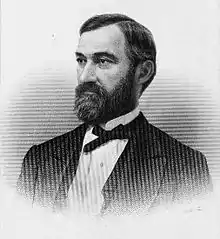DeWitt Clinton Littlejohn
DeWitt Clinton Littlejohn (February 7, 1818 – October 27, 1892) was a brevet brigadier general in the Union Army and a United States Representative from New York during the Civil War.
DeWitt Clinton Littlejohn | |
|---|---|
 DeWitt Clinton Littlejohn | |
| Born | February 7, 1818 Bridgewater, New York |
| Died | October 27, 1892 (aged 74) Oswego, New York |
| Place of burial | Riverside Cemetery, Oswego, New York |
| Allegiance | United States of America Union |
| Service/ | United States Army Union Army |
| Rank | |
| Battles/wars | American Civil War |
Biography
Littlejohn initially pursued an academic course at Geneva Academy. Deciding to not complete college, he instead engaged in several profitable mercantile pursuits, acting for a time as a forwarder of fresh produce on the lakes and canals of the region. He later engaged in the manufacture of flour at Oswego, New York.
He was Mayor of Oswego, New York in 1849 and 1850. He was a member of the New York State Assembly (Oswego Co., 1st D.) in 1853, 1854, 1855, 1857, 1859, 1860, 1861, 1866, 1867, 1870, 1871 and 1884. He was Speaker in 1855, 1857, 1859, 1860 and 1861; and was the chief lieutenant of political boss Thurlow Weed.
Early in 1861, Littlejohn was influential in the backroom politics to select Ira Harris over Horace Greeley as the Republican Party's nominee to run for the U.S. Senate to succeed William H. Seward, who had not run for re-election, expecting to join President Abraham Lincoln's Cabinet. In September, Littlejohn unsuccessfully sued Greeley and the New York Tribune for libel. With the outbreak of the Civil War in 1861, Littlejohn worked actively to recruit troops in the Oswego area.
Littlejohn used his political connections in July 1862 to secure a commission as Colonel of the 110th New York Volunteer Infantry, a regiment he helped raise through his personal efforts. He trained his troops at Camp Patterson near Baltimore, Maryland, where it was stationed until November, when it was ordered to Federal-occupied New Orleans, Louisiana.
Returning to politics, he successfully campaigned for the United States House of Representatives. He was elected as a Republican to the 38th United States Congress. He resigned from the army on February 3, 1863, and served in Congress from March 4, 1863, to March 3, 1865. During that term, he was Chairman of the Committee on Revolutionary Pensions. Littlejohn was not a candidate for renomination in 1864.
On February 26, 1867, President Andrew Johnson nominated Littlejohn for appointment to the grade of brevet brigadier general of volunteers, to rank from March 13, 1865, and the United States Senate confirmed the appointment on March 2, 1867.[1]
He moved his residence to Buffalo, New York until 1867, when he moved back to Oswego. Littlejohn wanted to afford Oswego the growth possible by a rail connection to a major port. In 1868, he organized and served as president of the New York and Oswego Midland Railroad (NY&OM), a route traversing much of New York State on its way to New York City.[2] He also established a steamboat service connecting Long Island to his new railroad.
In 1870 the Republican state convention nominated Littlejohn for Lieutenant Governor of New York on the ticket with Stewart L. Woodford, but he declined to run.
Fed up with the corruption of the Grant Administration, in 1872 Littlejohn joined the Liberal Republican Party and supported the candidacy of Horace Greeley for president in 1872, having set aside his previous legal issues with Greeley. He then became a Democrat, was a delegate to several Democratic state conventions, and was an ally of Samuel J. Tilden.
He died in Oswego, and was buried at the Riverside Cemetery.
References
- United States Congress. "DeWitt Clinton Littlejohn (id: L000357)". Biographical Directory of the United States Congress. Retrieved on 2008-02-12
- Obit in NYT, October 28, 1892
- Brown, John Howard, ed., Lamb's Biographical Dictionary of the United States. Volume V. Boston: James H. Lamb Co., 1903.
- Eicher, John H., and David J. Eicher, Civil War High Commands. Stanford: Stanford University Press, 2001. ISBN 978-0-8047-3641-1
Notes
- Eicher, John H., and David J. Eicher, Civil War High Commands. Stanford: Stanford University Press, 2001. ISBN 978-0-8047-3641-1. p. 741.
- Find-a-Grave
| New York State Assembly | ||
|---|---|---|
| Preceded by Edwin C. Hart |
New York State Assembly Oswego County, 1st District 1853-1855 |
Succeeded by Orville Robinson |
| Preceded by Orville Robinson |
New York State Assembly Oswego County, 1st District 1857 |
Succeeded by William Baldwin |
| Preceded by William Baldwin |
New York State Assembly Oswego County, 1st District 1859-1861 |
Succeeded by Elias Root |
| Preceded by Elias Root |
New York State Assembly Oswego County, 1st District 1866-1867 |
Succeeded by John A. Place |
| Preceded by Benjamin Doolittle |
New York State Assembly Oswego County, 1st District 1870-1871 |
Succeeded by Daniel G. Fort |
| Preceded by William A. Poucher |
New York State Assembly Oswego County, 1st District 1884 |
Succeeded by Henry C. Howe |
| Political offices | ||
| Preceded by Robert H. Pruyn |
Speaker of the New York State Assembly 1855 |
Succeeded by Orville Robinson |
| Preceded by Orville Robinson |
Speaker of the New York State Assembly 1857 |
Succeeded by Thomas G. Alvord |
| Preceded by Thomas G. Alvord |
Speaker of the New York State Assembly 1859–1861 |
Succeeded by Henry Jarvis Raymond |
| U.S. House of Representatives | ||
|---|---|---|
| Preceded by William E. Lansing |
Member of the U.S. House of Representatives from New York's 22nd congressional district 1863-1865 |
Succeeded by Sidney T. Holmes |